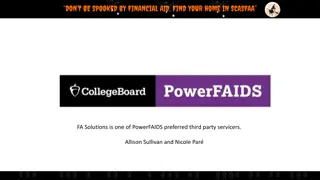Steps to Navigate a Financial Crisis - Practical Advice for Business Owners
Facing a sudden financial crisis can be daunting for businesses. This presentation outlines key steps to take, such as managing cash flow, prioritizing disbursements, exploring loan options, and evaluating cost control measures. By being proactive and realistic, businesses can increase their chances of weathering the storm successfully.
Download Presentation
Please find below an Image/Link to download the presentation.
The content on the website is provided AS IS for your information and personal use only. It may not be sold, licensed, or shared on other websites without obtaining consent from the author. Download presentation by click this link. If you encounter any issues during the download, it is possible that the publisher has removed the file from their server.
Presentation Transcript
VETRN PRESENTATION STEPS TO TAKE IN GETTING THROUGH A FINANCIAL CRISIS LEE GOLDBERG- PRESIDENT, FOUNDER DAVE FERRARA PROGRAM MANAGER 1
BACKGROUND TO A FINANCIAL CRISIS What happens when, suddenly, sales dry up, customers can t pay their invoices due to their own cash flow issues and you now have no choice but to scale back your operations and try to stay in business? You are now concerned about whether you will be able to remain profitable, have positive cash flow, draw a salary, pay your employees and pay critical vendors. DON T PANIC. Take a deep breath and start to figure out what needs to be done o get through this critical and unexpected financial crisis. You must be PROACTIVE in order to take the necessary steps that are now needed to stay in business. 2
COMPANIES ARE RUN BASED ON CASH FLOW CASH RECEIPTS: It is important to recognize that revenue does not equal cash receipts. There is always a lag between generating revenue and generating cash receipts You need to collect accounts receivable in order to generate cash. Follow up with your customers to make sure they are able to make their payments. Are there customers with aged accounts receivable with whom you should stop shipping product or providing services going forward? Are there customers who pay in a timely manner that are more reliable? Base your cash flow forecast on the reality of when you will collect your receivables Is there a way for you to make up for lost revenue by pivoting product or services? Most importantly, be realistic about your forecasted weekly cash receipts during the next 4 6 month period. 3
COMPANIES ARE RUN BASED ON CASH FLOW CASH DISBUREMENTS: Once you have recognized a realistic forecast of weekly cash receipts, you will need to list cash disbursements on a priority basis. The most important payments need to be listed first, such as payroll and payroll taxes, priority / critical vendor payments, then other necessary overhead expenses. If there is a negative cash flow balance after you have deducted the priority cash disbursements from your available cash, then you will need to make adjustments. For example, what can be pushed out that is not critical or can be cut? Do you need to maintain the current level of payroll? Are there key vendors you can call to push out payments? What about the landlord? Call your bank lender to discuss your cash flow situation and look into loan options. 4 What SBA Express Bridge Loans are available or other SBA programs? Managing your Cash Flow is Critical to Survival and Business Viability
COST OF SALES & OPERATING EXPENSES If sales have fallen, that will have a direct impact on availability of funds to meet your coat of sales and operating expenses. Determine whether your product or service is priced correctly and / or if operating expenses are too high, given the current demand for your product. If pricing and gross margin are low to begin with, then lower sales will mean a greater need to find ways to reduce your cost of sales and operating expenses. Can you pivot your sales, product or service to an area or market where this is a greater demand or unmet need? Can you reduce direct labor costs, purchases or operating expense items? Can you operate in less space and sub-lease unused warehouse space? What about reducing utility costs, freight or other direct or indirect expenses? 5 Don t be afraid to talk with your landlord about your inability to pay rent right now.
BREAKEVEN SALES CALCULATION The breakeven sales calculation shows the amount of sales needed to cover fixed operating expenses given the current gross margin percent of your business. If fixed operating expenses are $10,000 and the gross margin percent is 40%, then the amount of sales needed to cover the fixed operating expenses is $25,000. The sales breakeven formula is: fixed expenses / (100-varable cost of sales percent) If you are not at breakeven sales, then you are losing more money in your business the more sales you bring in ..and corrections need to be made. If sales are now reduced, then you will need to also reduce fixed operating expenses, such as selling, general and administrative expense items. You may also need to reduce or furlough employees. You should also check with your accountant or tax advisor to better understand unemployment benefit and tax considerations for furloughed employees. 6
PURCHASING / EXCESS NVENTORY Building enough inventory to meet your sales forecast is critical to meet your customer delivery needs, BUT . When sales decline, having too much inventory can lead to using up your much needed cash and taking on inventory risk. Inventory risk is when your inventory does not sell through and sits in the warehouse, becoming aged and worthless. INVENTORY IS ILLIQUID CASH Too much inventory will eat up your cash. so don t be afraid to call your vendors and tell them that you need to reduce outstanding purchase orders right now until sales pick up. Also, hold off on sending out new purchase orders right now until you have a better sense of customer demand and timing for your product. It is also important to time your inventory purchases and payment terms, so that cash is not upside down due to a lag in collecting your accounts receivable after shipments to your customers. 7
DONT BE UPSIDE DOWN WITH THE TRADE If you sell to a customer who is either not paying his invoices in a timely manner, returning product too frequently, is taking too much time to manage or where it is too costly to ship due to geographic location, then YOU SHOULD DROP THAT CUSTOMER. If your normal selling terms are net 30 days, then it is unacceptable to allow your customer to pay in 60-75 days or more. This is especially true when you are paying your own vendors in 30-45 days. BEING UPSIDE DOWN WITH THE TRADE IS A KILLER TO PROPERLY MANAGING CASH FLOW Look at how much inventory you really need to fulfill customer needs and make sure you are getting the proper inventory turn for your business. Manage your business based on actual sales needs, and, given the lead time for deliveries, DON T OVERPURHASE OR COMMIT MORE INVENTORY THAN ABSOLUTELY NECESSARY. 8
PROFESSONAL RESOURCES AVAILABLE When faced with a financial crisis, the most important thing to remember is DON T PANIC. You are not alone in having to deal with cash flow and crisis management issues. The Covid-19 Pandemic is unprecedented and affects everyone. SBA funding and other resources are available to assist you and your small business. Remember CASH IS KING Take the time to sit down and put together a detailed cash flow forecast and make the hard decisions to keep your business afloat until the economy improves. Don t be shy about reaching out for assistance from the Professional Resources available to assist you. These resources include: the Small Business Administration, Small Business Development Centers in your area, SCORE, Credit Officers at your bank, Turnaround Consultants, Insolvency Attorneys and the Turnaround Management Association, a professional organization dedicated to working with underperforming businesses. 9
GOOD LUCK FROM VETRN WWW.VETRN.ORG Lee Goldberg, Founder & President VETRN lelandg@vetrn.org (617) 901-6055 10

















































